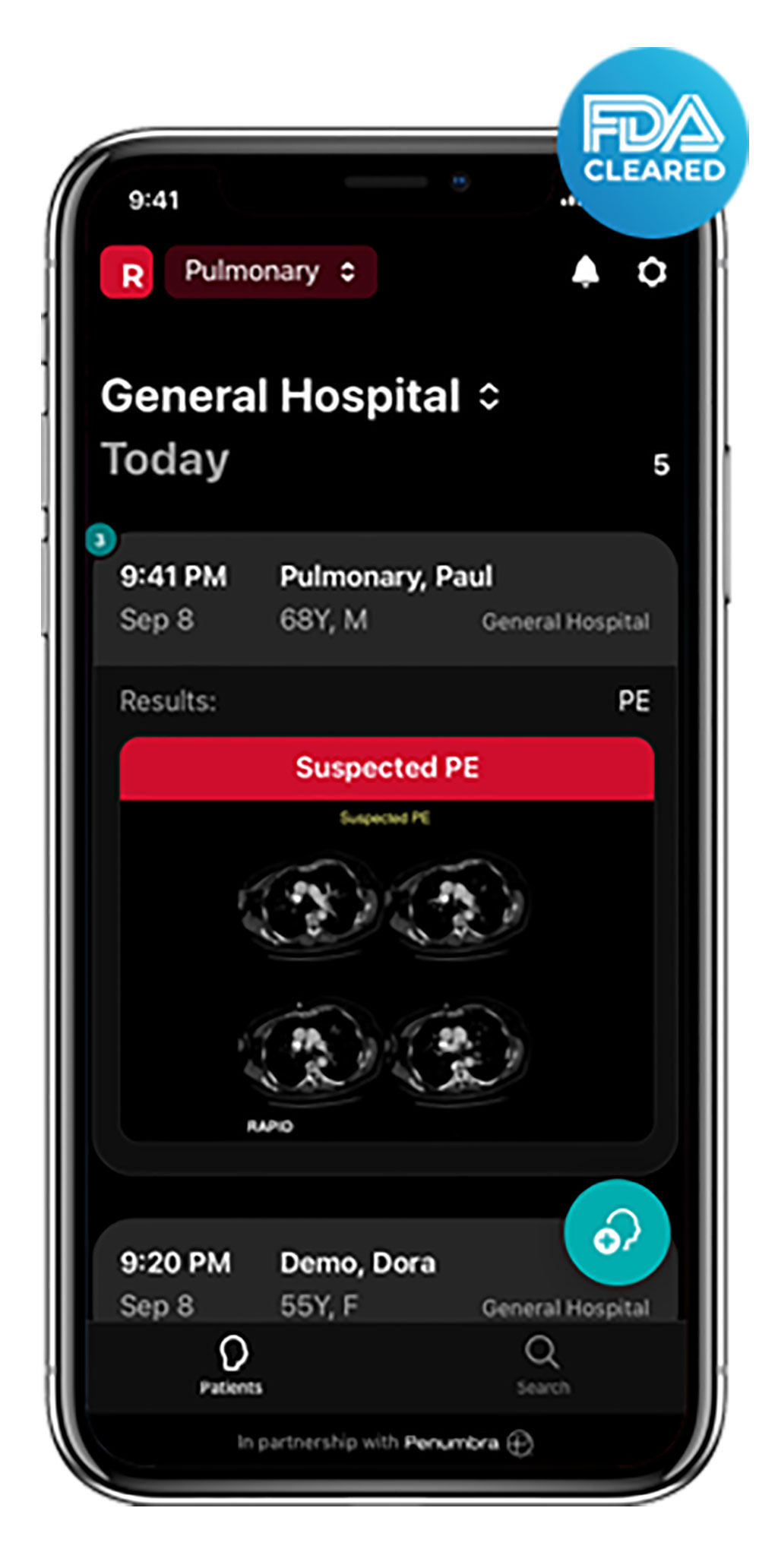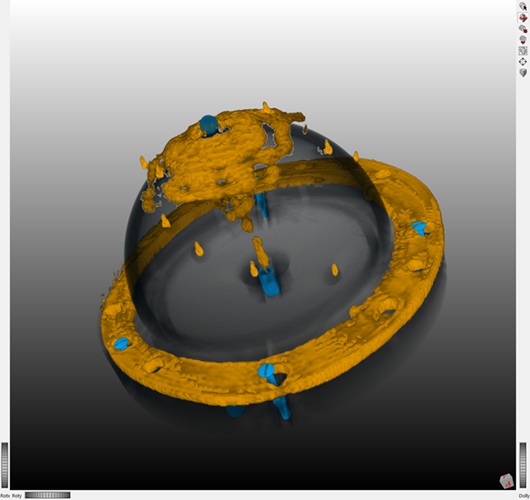AI Software Automatically Flags Suspected PEs in CT Images
|
By MedImaging International staff writers Posted on 31 May 2022 |

Over the last decade, death rates for pulmonary embolism (PE) have been on the rise, with the biggest increase among people under 65 years. For those who experience and survive a PE incident, one-third will have a recurrence within 10 years. Increasing access to clinically validated technology will be the key to helping hospitals more efficiently coordinate care, make accurate diagnoses in a timely manner, and get PE patients to treatment faster, leading to better outcomes. Now, a new clinically driven AI platform enables fast identification and communication of suspected central PE, extending the physicians’ ability to prioritize patients, reduce time to treatment and improve patient outcomes.
Modernizing PE care management means driving clinical, operational and financial efficiency. RapidAI (San Mateo, CA, USA) offers RapidAI solution for PE, a suite of products and services, that enables care teams to reach a new level of efficiency by leveraging technology to accelerate decision making and streamline the PE patient workflow. RapidAI solution for PE includes Rapid PE Triage & Notification, an AI-based clinical decision support tool that automatically identifies and sends notifications of suspected central PE on CTPA images - enabling teams to prioritize and accelerate time to treatment.
Getting the right physicians and team members aligned quickly means less time repeating information and more time diagnosing and treating patients. RapidAI solution for PE also includes Rapid Workflow for PE that modernizes workflow for easier care coordination and more efficient team communication. Physicians can preview CTPA images anywhere at any time via a mobile device, desktop or laptop. HIPAA-compliant messaging allows team members stay up to date on new cases, images and patient status. RapidAI has received FDA 510(k) clearance for its Rapid PE Triage & Notification product.
Rapid PE Triage & Notification, in conjunction with Rapid Workflow for PE, will enable care teams to more easily manage the entire patient care journey, from the moment a suspected PE patient is identified to diagnosis and through treatment. By automatically identifying a suspected PE and delivering real-time notifications to physicians, patients can be triaged faster and care teams aligned more quickly, reducing overall time to treatment.
“Building on our expertise in stroke, we’re confident this technology will help modernize PE care and meaningfully improve patient outcomes,” said Karim Karti, CEO of RapidAI. “Our goal is to build solutions that address the specific challenges associated with treating various conditions, as well as the communication and workflow issues faced by hospitals globally. From stroke to aneurysm to PE, we’re proud of how much RapidAI has grown and are excited to continue to redefine the patient care journey.”
Related Links:
RapidAI
Latest General/Advanced Imaging News
- Cutting-Edge Angio-CT Solution Offers New Therapeutic Possibilities
- Extending CT Imaging Detects Hidden Blood Clots in Stroke Patients
- Groundbreaking AI Model Accurately Segments Liver Tumors from CT Scans
- New CT-Based Indicator Helps Predict Life-Threatening Postpartum Bleeding Cases
- CT Colonography Beats Stool DNA Testing for Colon Cancer Screening
- First-Of-Its-Kind Wearable Device Offers Revolutionary Alternative to CT Scans
- AI-Based CT Scan Analysis Predicts Early-Stage Kidney Damage Due to Cancer Treatments
- CT-Based Deep Learning-Driven Tool to Enhance Liver Cancer Diagnosis
- AI-Powered Imaging System Improves Lung Cancer Diagnosis
- AI Model Significantly Enhances Low-Dose CT Capabilities
- Ultra-Low Dose CT Aids Pneumonia Diagnosis in Immunocompromised Patients
- AI Reduces CT Lung Cancer Screening Workload by Almost 80%
- Cutting-Edge Technology Combines Light and Sound for Real-Time Stroke Monitoring
- AI System Detects Subtle Changes in Series of Medical Images Over Time
- New CT Scan Technique to Improve Prognosis and Treatments for Head and Neck Cancers
- World’s First Mobile Whole-Body CT Scanner to Provide Diagnostics at POC
Channels
Radiography
view channel
AI Hybrid Strategy Improves Mammogram Interpretation
Breast cancer screening programs rely heavily on radiologists interpreting mammograms, a process that is time-intensive and subject to errors. While artificial intelligence (AI) models have shown strong... Read more
AI Technology Predicts Personalized Five-Year Risk of Developing Breast Cancer
Breast cancer remains one of the most common cancers among women, with about one in eight receiving a diagnosis in their lifetime. Despite widespread use of mammography, about 34% of patients in the U.... Read moreMRI
view channel
AI-Assisted Model Enhances MRI Heart Scans
A cardiac MRI can reveal critical information about the heart’s function and any abnormalities, but traditional scans take 30 to 90 minutes and often suffer from poor image quality due to patient movement.... Read more
AI Model Outperforms Doctors at Identifying Patients Most At-Risk of Cardiac Arrest
Hypertrophic cardiomyopathy is one of the most common inherited heart conditions and a leading cause of sudden cardiac death in young individuals and athletes. While many patients live normal lives, some... Read moreUltrasound
view channel
Non-Invasive Ultrasound-Based Tool Accurately Detects Infant Meningitis
Meningitis, an inflammation of the membranes surrounding the brain and spinal cord, can be fatal in infants if not diagnosed and treated early. Even when treated, it may leave lasting damage, such as cognitive... Read more
Breakthrough Deep Learning Model Enhances Handheld 3D Medical Imaging
Ultrasound imaging is a vital diagnostic technique used to visualize internal organs and tissues in real time and to guide procedures such as biopsies and injections. When paired with photoacoustic imaging... Read moreNuclear Medicine
view channel
New Camera Sees Inside Human Body for Enhanced Scanning and Diagnosis
Nuclear medicine scans like single-photon emission computed tomography (SPECT) allow doctors to observe heart function, track blood flow, and detect hidden diseases. However, current detectors are either... Read more
Novel Bacteria-Specific PET Imaging Approach Detects Hard-To-Diagnose Lung Infections
Mycobacteroides abscessus is a rapidly growing mycobacteria that primarily affects immunocompromised patients and those with underlying lung diseases, such as cystic fibrosis or chronic obstructive pulmonary... Read moreImaging IT
view channel
New Google Cloud Medical Imaging Suite Makes Imaging Healthcare Data More Accessible
Medical imaging is a critical tool used to diagnose patients, and there are billions of medical images scanned globally each year. Imaging data accounts for about 90% of all healthcare data1 and, until... Read more
Global AI in Medical Diagnostics Market to Be Driven by Demand for Image Recognition in Radiology
The global artificial intelligence (AI) in medical diagnostics market is expanding with early disease detection being one of its key applications and image recognition becoming a compelling consumer proposition... Read moreIndustry News
view channel
GE HealthCare and NVIDIA Collaboration to Reimagine Diagnostic Imaging
GE HealthCare (Chicago, IL, USA) has entered into a collaboration with NVIDIA (Santa Clara, CA, USA), expanding the existing relationship between the two companies to focus on pioneering innovation in... Read more
Patient-Specific 3D-Printed Phantoms Transform CT Imaging
New research has highlighted how anatomically precise, patient-specific 3D-printed phantoms are proving to be scalable, cost-effective, and efficient tools in the development of new CT scan algorithms... Read more
Siemens and Sectra Collaborate on Enhancing Radiology Workflows
Siemens Healthineers (Forchheim, Germany) and Sectra (Linköping, Sweden) have entered into a collaboration aimed at enhancing radiologists' diagnostic capabilities and, in turn, improving patient care... Read more





















